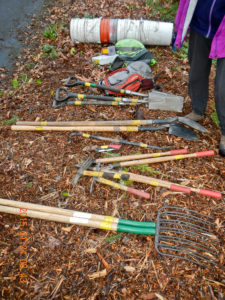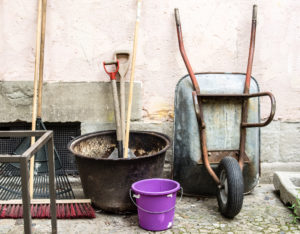Gardening is a relaxing and rewarding hobby, but it’s important to have the right tools to make the job easier. However, even the best tools will eventually wear out or become dull if not properly maintained. In this blog, we will discuss the best practices for maintaining your gardening tools so that they last for many years to come. We will cover topics such as cleaning, sharpening, rust removal, and storage to help you keep your tools in top condition. Whether you’re a seasoned gardener or a beginner, this guide will provide you with the information you need to keep your tools in good working order. So, let’s dive in and learn how to properly care for your gardening tools to ensure that they last for many seasons to come!
Quick Tips for Tool Maintenance
The best way to maintain gardening tools is to clean them after each use and to store them in a dry place. This will remove any dirt or debris that may have accumulated on the tools, and will help to prevent rust and other forms of corrosion.
Sharpening the blades of your tools regularly is also an important step in maintaining them. This will help to ensure that they work efficiently and effectively and will also prolong the life of the tools.
It’s a good idea to inspect tools for any signs of wear and tear and repair or replace them as necessary. This will help to ensure that they stay in good working condition and do not pose a safety hazard.
Regularly lubricating the moving parts of the tools, such as the hinge of a pair of shears, is also important to keep them working smoothly.
Finally, for long-term storage, it’s best to keep the tools in a dry, well-ventilated space, such as a garden shed or garage, to prevent rust and other forms of corrosion.
Garden Tool Storage

To store gardening tools properly, it is important to keep them in a dry and well-ventilated space, such as a garden shed or garage. This will help to prevent rust and other forms of corrosion.
You can also use a tool rack or hooks to hang the tools in an organized manner. This will help to keep them off the ground and will also make it easier to find the tool you need when you need it.
Additionally, it’s a good idea to store sharp tools separately from other tools to avoid any injury.
Sharpening your Garden Tools
It is good practice to sharpen your tools. Dull blades will not only fail to cut properly, but they risk slipping, which can cause you to accidentally cut yourself. Certain gardening tools that require sharpening. These include:

Hand pruners: They are used for cutting small branches and twigs and should be sharpened with a sharpening stone or file.
Loppers: They are used for cutting larger branches and twigs, and also should be sharpened with a sharpening stone or file.
Hedge shears: They are used for trimming hedges and should be sharpened with a sharpening stone or file.
Lawn mower blades: They should be sharpened with a file or rotary tool.
Axe and hatchet: They should be sharpened with a file or a wet stone.
When sharpening, it’s important to use the correct angle and technique to sharpen the blade. For most tools, you should sharpen at a slight angle (around 20-25 degrees) to maintain the tool’s bevel. Use a honing guide to help you maintain the correct angle if you’re not confident in your ability to hold the angle by hand.
It’s also important to use the correct grit of sharpening stone or file. A coarse grit should be used to remove nicks or chips in the blade, while a finer grit should be used to sharpen and hone the edge.
It’s also important to keep safety in mind while sharpening. Wear protective gear and use a clamp or vise to hold the tool securely while you sharpen it. Finally, after sharpening, you may want to use honing oil to protect the blade and make it easier to sharpen next time.
Removing Rust from Garden Tool
There are several ways to remove rust from gardening tools, but some methods are more effective than others. Some of the most effective ways to remove rust include:

Using a wire brush or sandpaper: This method is effective for removing rust from small areas of the tool. Use a wire brush or sandpaper to scrub away the rust, being careful not to damage the metal.
Using a rust remover solution: This method is effective for removing rust from larger areas of the tool. There are several commercial rust remover solutions available, such as naval jelly, that can be applied to the rusted area and left to sit for a specified amount of time before being wiped or scrubbed off.
Using a mixture of baking soda and water: This method can be effective for removing rust from small areas of the tool. Mix baking soda and water to create a paste, apply the paste to the rusted area, and then scrub with a wire brush or sandpaper.
Using white vinegar and baking soda: Mix equal parts of white vinegar and baking soda to create a paste, apply the paste to the rusted area, and leave it on for a few hours. Scrub the paste off with a wire brush or steel wool, and then rinse the tool with water.
Using lemon and salt: Cut a lemon in half, sprinkle salt on the cut side, and rub it over the rust. The acid in the lemon juice will dissolve the rust, and the salt will act as an abrasive to help scrub it away.
It’s important to note that some of these methods may cause damage to the metal if not used correctly or left on for too long, so be sure to follow the instructions and take precautions when using any rust removal solution.
In conclusion, maintaining your gardening tools is an essential part of keeping your garden in top shape. By regularly cleaning, sharpening, removing rust, and storing your tools properly, you can ensure that they last for many years to come. Proper maintenance not only prolongs the life of your tools but also makes them more efficient and effective to use. Remember to always use the correct method and techniques, and to always practice safety precautions when working with tools.
By following the tips and advice outlined in this blog, you’ll be able to keep your gardening tools in top condition and enjoy a beautiful and well-maintained garden all season long. If you have other tips to recommend on how to maintain your gardening tools, share your thoughts in our gardening community.

Contact Author
 info@gardensavvy.com
info@gardensavvy.com Recent Posts
- Smart Gardening: How Technology Is Revolutionizing Horticulture
- Understanding Gardening Zones: What You Need to Know
- The Right Tools For Your Gardening And Landscaping Needs
- Maximizing Your Harvest: Square Foot Gardening Chart for Beginners
- Holiday Garden Scents: Plants for Natural Aromatherapy in Your Home






